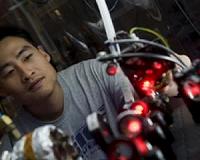 |
New Haven CT (SPX) Sep 30, 2010 The rules that govern the world of the very small, quantum mechanics, are known for being bizarre. One of the strangest tenets is something called quantum entanglement, in which two or more objects (such as particles of light, called photons) become inextricably linked, so that measuring certain properties of one object reveals information about the other(s), even if they are separated by thousands of miles. Einstein found the consequences of entanglement so unpalatable he famously dubbed it "spooky action at a distance." Now a team led by Yale researchers has harnessed this counterintuitive aspect of quantum mechanics and achieved the entanglement of three solid-state qubits, or quantum bits, for the first time. Their accomplishment, described in the journal Nature, is a first step towards quantum error correction, a crucial aspect of future quantum computing. "Entanglement between three objects has been demonstrated before with photons and charged particles," said Steven Girvin, the Eugene Higgins Professor of Physics and Applied Physics at Yale and an author of the paper. "But this is the first three-qubit, solid-state device that looks and feels like a conventional microprocessor." The new result builds on the team's development last year of the world's first rudimentary solid-state quantum processor, which they demonstrated was capable of executing simple algorithms using two qubits. The team, led by Robert Schoelkopf, the William A. Norton Professor of Applied Physics and Physics at Yale, used artificial "atoms"-actually made up of a billion aluminum atoms that behave as a single entity-as their qubits. These "atoms" can occupy two different energy states, akin to the "1" and "0" or "on" and "off" states of regular bits used in conventional computers. The strange laws of quantum mechanics, however, allow for qubits to be placed in a "superposition" of these two states at the same time, resulting in far greater information storage and processing power. In this new study, the team was able to achieve an entangled state by placing the three qubits in a superposition of two possibilities-all three were either in the 0 state or the 1 state. They were able to attain this entangled state 88 percent of the time. With the particular entangled state the team achieved, they also demonstrated for the first time the encoding of quantum information from a single qubit into three qubits using a so-called repetition code. "This is the first step towards quantum error correction, which, as in a classical computer, uses the extra qubits to allow the computer to operate correctly even in the presence of occasional errors," Girvin said. Such errors might include a cosmic ray hitting one of the qubits and switching it from a 0 to a 1 state, or vice versa. By replicating the qubits, the computer can confirm whether all three are in the same state (as expected) by checking each one against the others. "Error correction is one of the holy grails in quantum computing today," Schoelkopf said. "It takes at least three qubits to be able to start doing it, so this is an exciting step." Other authors of the paper include Leonardo DiCarlo, Matthew Reed, Luyan Sun, Blake Johnson, Jerry Chow and Michel Devoret (all of Yale University); and Jay Gambetta (University of Waterloo). Citation: DOI: 10.1038/nature09416
Share This Article With Planet Earth
Related Links Yale University Understanding Time and Space
 One-Dimensional Window On Superconductivity And Magnetism
One-Dimensional Window On Superconductivity And MagnetismHouston TX (SPX) Sep 30, 2010 A Rice University-led team of physicists is reporting the first success in a three-year effort to build a precision simulator for superconductors using a grid of intersecting laser beams and ultracold atomic gas. The research appears this week in the journal Nature. Using lithium atoms cooled to within a few billionths of a degree of absolute zero and loaded into optical tubes, the researc ... read more |
|
| The content herein, unless otherwise known to be public domain, are Copyright 1995-2010 - SpaceDaily. AFP and UPI Wire Stories are copyright Agence France-Presse and United Press International. ESA Portal Reports are copyright European Space Agency. All NASA sourced material is public domain. Additional copyrights may apply in whole or part to other bona fide parties. Advertising does not imply endorsement,agreement or approval of any opinions, statements or information provided by SpaceDaily on any Web page published or hosted by SpaceDaily. Privacy Statement |